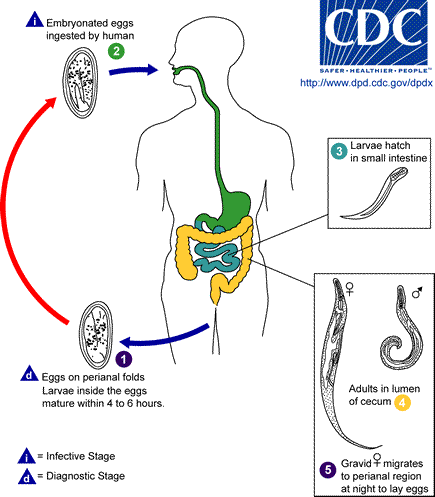Enterobiasis pathophysiology
|
Enterobiasis Microchapters |
|
Diagnosis |
|---|
|
Treatment |
|
Case Studies |
|
Enterobiasis pathophysiology On the Web |
|
American Roentgen Ray Society Images of Enterobiasis pathophysiology |
|
Risk calculators and risk factors for Enterobiasis pathophysiology |
Editor-In-Chief: C. Michael Gibson, M.S., M.D. [1]
Pathophysiology
Overview
Pathogenesis
- It is postulated that Enterobius vermicularis triggers an inflammatory response which is associated with the low-grade eosinophilia. Allergic response to the worm protein is considered to be the cause of pruritus; usually pruritus ani (perianal pruritus).
- The infective eggs of E. vermicularis are ingested via contaminated hands or fomites(clothing, toys, bed, furniture, animals' fur etc). The eggs mature into adult Enterobius in 15-40 days. Male adult larvae fertilize the female (in lower ileum) and are passed out in stools without producing symptoms. Adult females settle in the lower ileum, caecum, appendix and ascending colon. The gravid worm migrates from the colon to the rectal area. At night eggs laid on the perianal skin by the uterine contraction(s) of the gravid worm.
- At oviposition, the eggs are immature and non-infective. They become infective within 6 hours at body temperature. In cool, moist environment with little ventilation eggs remain viable for up to three weeks. However, the infectivity decreases with time. Eggs do not tolerate heat that well which might be the reason that enterobiasis is more common in temperate than tropical climates.
- Rarely the worm is found in vagina and more rarely in liver
The image shown below depicts the life cycle of the pinworm (For all practical purposes, the morphology, life cycle, clinical presentation, and treatment of E. gregorii is identical to E. vermicularis).

Habitat
The pinworm lives in the large intestine and cecum. It is found worldwide, and causes the most common infection enterobiasis in humans. Unlike many other intestinal parasites, the pinworm does not usually enter the bloodstream or any other organs besides the intestines. Only in rare cases pinworms are found in the vagina, and even more rarely in the uterus, fallopian tubes, liver, and peritoneum, but the worms cannot survive long in these places.
The human pinworm Enterobius vermicularis is a ubiquitous parasite of man, it is estimated that over 200 million people are infected annually. It is more common in the temperate regions of Western Europe and North America, (it being relatively rare in the tropics) and is found particularly in children. Samples of Caucasian children in the U.S.A. and Canada have shown incidences of infection of between 30% to 80%, with similar levels in Europe.
Mode of Transmission
E. Vermicularis is transmitted via these four modes:
- Direct infection from the anal and perianal regions by infected fingernails.
- Exposure to viable eggs on fomites (clothing, toys, bed, furniture, fur of pets etc).
- By dust contaminated with embryonated(infected) eggs.
- Retroinfection; migration of the larvae into sigmoid colon & caecum after hatching on the anal mucosa.
Microscopic Pathology
Histopathology of Appendix Showing Pinworms {{#ev:youtube|PkemlmA_tf0}}
Gallery
-
Life cycle of Enterobius vermicularis, otherwise known as the human pinworm. From Public Health Image Library (PHIL). [2]
References
- ↑ Rudolph's Pediatrics - 21st Ed. 2003; Current Medical Diagnosis & Treatment - 45th Ed. 2006
- ↑ "Public Health Image Library (PHIL)".
![Life cycle of Enterobius vermicularis, otherwise known as the human pinworm. From Public Health Image Library (PHIL). [2]](/images/5/53/Pinworm05.jpeg)